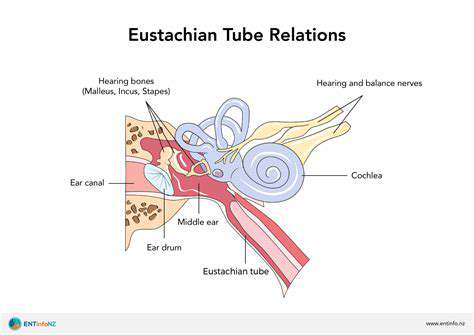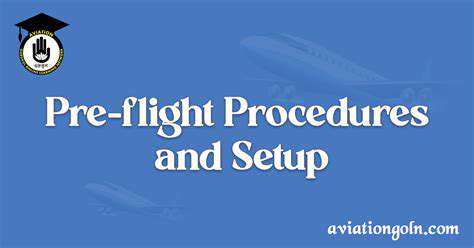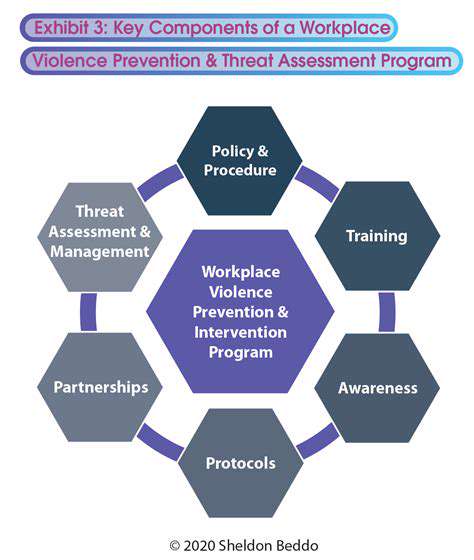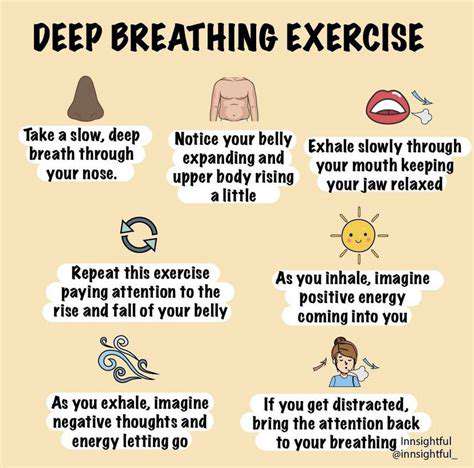The Impact of Air Travel Pressure Changes on Migraines

The Role of Eustachian Tube Dysfunction

Eustachian Tube Anatomy and Function
The Eustachian tube, a narrow passage connecting the middle ear to the nasopharynx, plays a crucial role in maintaining healthy middle ear pressure. Its primary function is to equalize pressure on both sides of the eardrum, allowing for optimal sound transmission. This delicate balance of pressure is essential for clear hearing and prevents discomfort or damage to the eardrum.
Understanding the structure of the Eustachian tube is vital to appreciating its function. It's a complex, cartilaginous and muscular structure that opens and closes in response to various stimuli. This dynamic opening and closing process is essential for regulating middle ear pressure, ensuring that the air pressure inside the middle ear matches the air pressure outside.
Causes of Eustachian Tube Dysfunction
Eustachian tube dysfunction (ETD) can arise from a variety of factors. Viral infections, such as the common cold, are frequently implicated in ETD. These infections can cause inflammation and swelling in the tissues surrounding the Eustachian tube, hindering its proper function.
Allergies, nasal congestion, and even structural abnormalities of the nasal passages or throat can also contribute to ETD. These conditions can obstruct the Eustachian tube, preventing proper air flow and leading to pressure imbalances.
Symptoms of Eustachian Tube Dysfunction
The symptoms of Eustachian tube dysfunction can vary significantly, depending on the severity and underlying cause. Common symptoms include ear fullness, popping or clicking sounds in the ears, and difficulty with hearing.
Sometimes, sufferers experience pain or pressure in the ears, especially when changing altitudes or during air travel. Other symptoms may include a feeling of congestion or a stuffy nose.
Diagnosis of Eustachian Tube Dysfunction
Diagnosis of ETD typically involves a comprehensive evaluation by an otolaryngologist (ENT). A thorough history, including details about symptoms, potential contributing factors, and medical history is essential.
Physical examination of the ears, nose, and throat is performed to assess for any visible signs of inflammation, obstruction, or structural abnormalities. In some cases, further diagnostic tests, such as tympanometry or acoustic reflectometry, may be necessary to evaluate middle ear function and pressure.
Treatment Options for Eustachian Tube Dysfunction
Treatment for ETD depends on the underlying cause and the severity of symptoms. Mild cases of ETD often resolve on their own within a few days or weeks, with supportive measures such as nasal saline sprays or decongestants.
More persistent or severe cases may require medical intervention, such as medications to reduce inflammation or, in some instances, surgical procedures to address structural abnormalities.
Prevention Strategies
Preventing Eustachian tube dysfunction involves proactive measures to maintain nasal and throat health. Regularly practicing good hygiene, such as washing hands frequently and avoiding contact with individuals who have upper respiratory infections, is essential.
Managing allergies effectively and seeking prompt treatment for nasal congestion are critical steps to prevent ETD. Maintaining a healthy lifestyle, including getting enough rest and consuming a balanced diet, can also contribute to a stronger immune system and reduce the risk of infections.
Long-Term Management and Outlook
Long-term management of ETD focuses on addressing the underlying causes and managing symptoms. Regular check-ups with an ENT are crucial to monitor the condition and assess the effectiveness of treatment.
The outlook for individuals with ETD is generally positive, especially when the condition is addressed promptly and effectively. With proper management, many individuals can maintain healthy hearing and quality of life.
Migraine Triggers and Predisposition
Understanding Migraine Triggers
Migraines are complex neurological disorders, and identifying their triggers is crucial for effective management. While the exact mechanisms aren't fully understood, a variety of factors can contribute to the onset of a migraine attack. These factors can range from environmental stimuli to internal bodily changes, making it a challenge for individuals to pinpoint and avoid all potential triggers.
Environmental factors, such as changes in weather patterns, strong smells, or bright lights, can often act as migraine triggers. Furthermore, stress, both physical and emotional, can play a significant role in the development of a migraine. Dietary factors, including specific foods or food additives, can also be potent migraine triggers, impacting individuals differently.
Genetic Predisposition to Migraines
A significant aspect of migraine predisposition involves genetics. Research suggests a strong hereditary component, meaning individuals with a family history of migraines are more likely to experience them themselves. This genetic vulnerability is often coupled with other factors, such as environmental triggers and lifestyle choices, which can influence the frequency and intensity of migraine attacks.
Understanding the genetic predisposition to migraines is vital for developing personalized strategies for prevention and management. While specific genes are yet to be definitively identified, studies highlight the complex interplay between inherited traits and environmental exposures in determining an individual's susceptibility to migraines.
Dietary Factors and Migraine Attacks
Certain foods and drinks can act as potent triggers for migraine sufferers. These include foods rich in tyramine, aged cheeses, processed meats, and even chocolate. Additionally, caffeine withdrawal, skipping meals, or consuming large amounts of alcohol can also lead to migraine attacks.
Dietary modifications are often an important part of migraine management. Identifying personal triggers through meticulous dietary logs and consulting with a healthcare professional can help individuals avoid those foods and drinks that exacerbate their migraines. This can lead to significant improvements in their quality of life.
Stress and its Impact on Migraines
Stress, whether acute or chronic, is a well-recognized migraine trigger. The body's stress response can lead to vasoconstriction and dilation, potentially impacting the blood vessels in the brain, which are crucial in migraine pathophysiology. Stressful life events, work pressures, or even everyday anxieties can all contribute to migraine attacks.
Environmental Factors and Migraine Onset
Environmental factors play a crucial role in triggering migraines, and these factors vary significantly from person to person. Changes in weather patterns, such as barometric pressure fluctuations, can be a significant trigger for some individuals. Similarly, strong smells, bright lights, and even loud noises can induce migraine attacks in susceptible individuals.
Environmental awareness is essential for migraine sufferers. Paying attention to personal triggers and taking steps to manage environmental factors can significantly reduce the frequency and severity of migraine attacks. This might include using scent diffusers, adjusting lighting in workspaces, or taking breaks from loud environments.
Hormonal Fluctuations and Migraines
Hormonal fluctuations, particularly in women, are often linked to migraine occurrences. Fluctuations in estrogen levels during menstruation, pregnancy, or menopause can impact the blood vessels in the brain, potentially leading to migraines. These hormonal changes can cause significant variations in migraine frequency and intensity, and a strong correlation exists between these fluctuations and migraine onset.
Recognizing the connection between hormonal fluctuations and migraines is vital for developing effective preventative strategies. Understanding the specific hormonal patterns in each individual can be instrumental in tailoring treatment plans and improving overall migraine management.
Strategies to Mitigate the Risk During Flights
Understanding Cabin Pressure Changes
Air travel, while convenient, exposes passengers to significant changes in atmospheric pressure. Understanding these changes is crucial for mitigating potential risks. The pressurized cabin environment, significantly lower than the atmospheric pressure at higher altitudes, can lead to discomfort and, in some cases, more serious issues. This pressure difference is a key factor to consider when planning and preparing for flights, especially for individuals with pre-existing health conditions.
Comprehending the mechanics of cabin pressurization is essential. As the plane ascends, the cabin pressure decreases to match the lower atmospheric pressure at altitude. Conversely, as the plane descends, the cabin pressure increases, mirroring the surrounding air pressure. These pressure fluctuations can affect the body's systems and, if not managed properly, potentially trigger or exacerbate certain health conditions.
Hydration and Dietary Considerations
Maintaining adequate hydration before, during, and after flights is vital for mitigating the impact of cabin pressure changes. Dehydration can exacerbate the effects of altitude sickness and other related symptoms. Drinking plenty of water throughout the flight is highly recommended, and avoiding alcohol and caffeine, which can contribute to dehydration, is also a wise choice.
Dietary choices also play a role. Consuming foods rich in electrolytes, such as fruits and vegetables, can help replenish lost fluids and minerals. Avoid overly salty or processed foods, as these can further dehydrate the body.
Pre-Flight Preparation and Medications
Proper pre-flight preparation can significantly reduce the risk of discomfort or complications. This includes ensuring you're well-hydrated and have consumed a balanced meal a few hours before takeoff. If you have any pre-existing medical conditions, such as cardiovascular issues or respiratory problems, it's critical to discuss your specific needs with your physician before flying. They can provide personalized advice and guidance on managing potential risks.
If you regularly take medications, consult your physician about potential adjustments to your dosage or timing in relation to the flight. Some medications might need to be taken differently during the flight to counteract the effects of the changing pressure.
In-Flight Strategies for Comfort
While in-flight, engaging in simple strategies can enhance comfort and minimize potential issues. Staying hydrated by drinking water regularly is crucial. Avoiding strenuous activities and maintaining a relaxed posture can help to reduce stress on the body.
Deep breathing exercises can aid in managing any feelings of discomfort or anxiety. Using nasal saline sprays or humidifiers can help maintain adequate nasal moisture, preventing dryness and potential complications.
Recognizing and Managing Symptoms
It's essential to be aware of the potential symptoms associated with air travel pressure changes, such as ear pain, sinus pressure, or headaches. Recognizing these symptoms early on can allow for prompt action. Gentle chewing or yawning can sometimes help alleviate ear pressure discomfort. If symptoms persist or worsen, it's crucial to seek immediate medical attention.
Post-Flight Recovery
After landing, it's important to continue hydrating and allow your body to gradually adjust to the normal atmospheric pressure. Listen to your body and take extra care if you experience any lingering discomfort. If symptoms persist for an extended period, consult your physician for further evaluation.
Taking it easy for the rest of the day and avoiding strenuous activities can facilitate your body's recovery process after a flight.
Pre-flight Preparation and In-flight Management

Pre-Flight Checklist
Before embarking on any flight, meticulous pre-flight preparation is paramount. This involves confirming the aircraft's mechanical condition, ensuring all necessary documentation is in order, and verifying the weather forecast. A comprehensive pre-flight checklist serves as a vital guide, ensuring no critical detail is overlooked. Proper preparation significantly minimizes the risk of unexpected issues during the flight, enhancing overall safety and efficiency.
Crucially, the pre-flight checklist should encompass a thorough inspection of all systems, including the engine, fuel, hydraulics, and electrical components. This proactive approach allows for the prompt identification and resolution of any potential problems, preventing them from escalating into more serious issues. It's essential to adhere to established procedures and regulations to guarantee a smooth and safe flight operation.
Documentation Review
Reviewing all necessary documentation is a critical step in pre-flight preparation. This includes the aircraft's maintenance records, flight permits, and any relevant airworthiness certificates. Accurate and up-to-date documentation is essential for compliance with regulations and ensures the aircraft is airworthy. Failure to review and verify this documentation could lead to significant delays or even the grounding of the aircraft.
Weather Conditions Assessment
A detailed assessment of the weather conditions is crucial for a safe flight. This involves checking the forecast for potential turbulence, adverse weather phenomena, and visibility limitations. Understanding the expected weather conditions allows pilots to make informed decisions regarding flight route and altitude. A comprehensive knowledge of the weather forecast and its potential impact on the flight is paramount for a smooth and safe journey.
Fuel Management
Proper fuel management is vital for any flight. This involves checking the fuel levels, verifying the fuel quality, and ensuring the fuel system is functioning correctly. Adequate fuel reserves are critical for maintaining safety margins and ensuring the aircraft can complete the intended flight. Insufficient fuel can lead to serious safety concerns. Proper fuel management is a cornerstone of safe flight operations.
Passenger and Cargo Briefing
Briefing passengers and cargo handlers on the flight procedures and safety protocols is essential. This includes clarifying potential safety hazards, outlining emergency procedures, and providing clear instructions for handling and securing cargo. Clear communication and understanding among all parties involved are crucial for a smooth and secure flight. This ensures all passengers and cargo are aware of their responsibilities. Effective pre-flight briefings are a vital component of ensuring a safe and efficient operation.
In-Flight Procedures
In-flight procedures encompass a wide range of activities, including maintaining communication with air traffic control, monitoring aircraft systems, and adjusting flight plans as needed. These procedures ensure the aircraft remains within safe operating parameters. Proactive monitoring and adherence to established procedures are paramount for safety. Understanding and properly executing in-flight procedures is essential for the safe and efficient completion of any flight.









